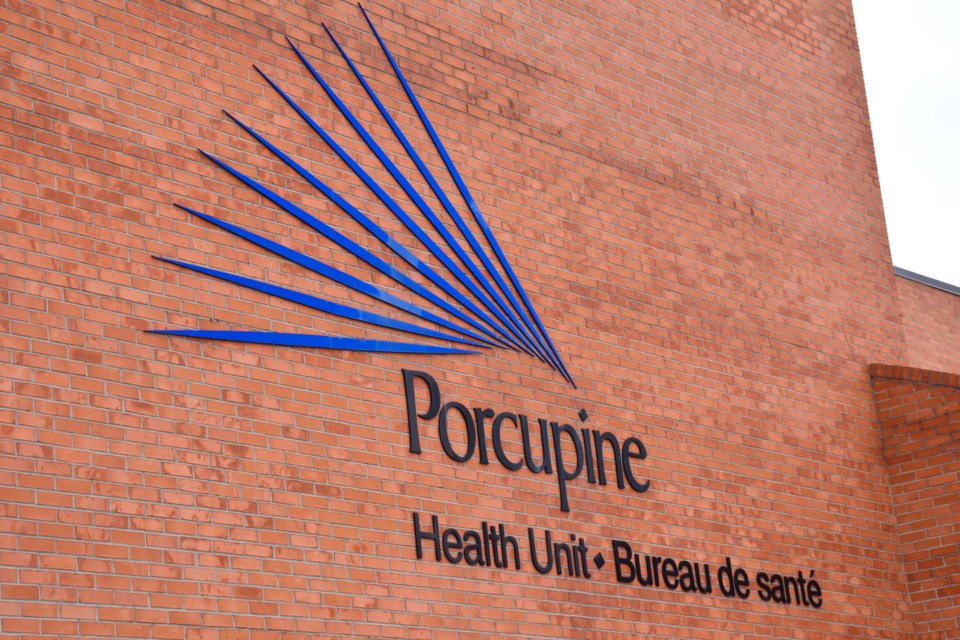Women account for more than half of the confirmed COVID-19 cases in the Porcupine Health Unit region, according to a new report.
The organization has released its second epidemiology report for local COVID-19 cases. The report includes the numbers from March 1 to the end of day May 8.
At that time, there were 64 confirmed cases, five deaths, 49 resolved cases, and 2,896 people had been tested in the Porcupine Health Unit region.
From the last report May 4, the number of cases in the region increased by four, which is a 6.7 per cent increase. One new virus-related death was also reported.
When the report was compiled, 35 cases (55 per cent) were female. There have been 29 males who tested positive.
The 60 to 79 year age bracket remains the top category, with 24 of the local cases falling into it. It's followed by 40 to 59 years, where there have been 17 cases.
Timmins has the highest number of cases, followed by the area of Matheson, Iroquois Falls, Cochrane and Smooth Rock Falls.
The case fatality rate in the Porcupine Health Unit area is 7.8 per cent, which is slightly lower than the provincial 7.9 per cent.
The local percentage of resolved cases is 76.6, while the Ontario's percentage is 71.4 per cent.
According to the report, the rate of testing per 100,000 population in the Timmins area is 3,476 and there is 2.5 per cent rate of positive tests. The provincial tests per 100,000 is 2,709, with an average of 5.1 per cent being positive.
Compared to other Northern Ontario health units, the Porcupine Health Unit continues to have the highest rate of infection, as well as the highest fatality rate.
According to the the PHU report, the numbers across the north as of May 8 were:
-
Algoma Public Health, 16 confirmed cases, which is an increase of three from the last report, and no deaths. The tests per 100,000 population are 4,264.8, with 0.6 per cent being positive.
-
North Bay Parry Sound District Health Unit, 18 confirmed cases, which is an increase of one from the last report, and no deaths. The tests per 100,000 are 2,543.9, 0.7 per cent being positive.
-
Northwestern Health Unit, 16 confirmed cases, no deaths. The tests per 100,000 are 3,196.4, with 0.9 per cent being positive.
-
Porcupine Health Unit, 64 positive, which is an increase of four from the last report. There have been five deaths, including one since the last report, making the fatality rate 7.8 per cent. The tests per 100,000 population are 3,467.6, with 2.5 per cent being positive.
-
Public Health Sudbury and Districts, 59 confirmed cases. There have been two deaths, with the fatality rate being 3.4 per cent. The tests per 100,000 population is 3,952.2, with 0.9 per cent being positive.
-
Thunder Bay District Health Unit, 77 confirmed cases, which is an increase of three from the last report. One person has died, making the fatality rate 1.3 per cent. The tests per 100,000 population is 3,743.6, with 1.4 per cent being positive.
-
Timiskaming Health Unit, 18 confirmed cases and no deaths. The testing per 100,000 population is 4,818.7, with 1.2 per cent being positive.
For all of Northern Ontario, when the report was completed there were 268 confirmed cases, which is 11 more than the May 4 report. There have been eight deaths, an increase of one from the last report, with the fatality rate being 3 per cent. The testing per 100,000 population is 3,610.1, with 1.1 per cent being positive.
Across the province, at the time of the report, there were 19,598 confirmed cases, including 1,540 deaths for a fatality rate of 7.9 per cent. The testing rate per 100,000 population was 2,709, with 5.1 per cent being positive.
The full epidemiology report can be found online here.
Because of the area's low population and case numbers, when the epidemiology reports were announced Porcupine Health Unit medical officer of health Dr. Lianne Catton said it isn't something that can be used to predict risk in particular groups or make broader statements. She noted the percentages and rates can change quickly with very small changes in the number of cases.



